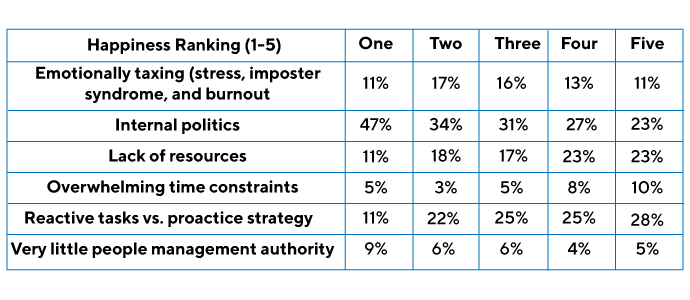Product management isn’t for everyone. For example, some product managers might love hearing product management is “responsibility without authority.” For others, this can send them running heading for the hills. Then there’s the lack of tangible outputs, as you’re not the one writing code, crafting marketing copy or closing deals. You also must communicate with so many different audiences and stakeholders, all of whom care about different things and might not even speak the same language. And, of course, there’s the “Swiss army knife” facet of the job, which means preparing for whatever gets thrown at you. There’s a lot that product managers dislike about their product management jobs.
A quick silver-lining moment….
Most people thrive in this environment and love the diversity, unpredictability, and interpersonal interactions it requires. This includes 92% of our survey respondents, who said they’re likely to remain in their current role. Others don’t— different strokes for different folks.
Here’s what Product Managers Dislike About Product Management
But even product managers that like-if-not-love those aspects of the job can have some legitimate gripes about their work environment, company culture, and coworkers. In our 2020 product management report, we surveyed more than 2,500 product managers from around the world. We found a few trends for the least favorite facets of being a product manager.
No single aspect of the job was disliked most by the majority of respondents. However, internal politics (28%), having to work on reactive tasks versus proactive strategy (25%), and a lack of resources (21%) were the most common responses.
Let’s take a closer look at the top two:
Internal politics
Dealing with internal politics isn’t unique to product management. Every employee in any company is either actively participating in the game or subject to its fallout.
But for product managers, internal politics can be an acute pain point due to the cross-functional nature of the role. Most workers don’t have to deal with every department. Their interactions usually limited to a subset of the total organization.
Product management must not only work with all these various stakeholders, but they need to get them to agree to things regularly. It puts them at the center of many political spats, power grabs, and ideological disagreements. They must facilitate resolutions that make decisions and set the product strategy so that implementation can move forward.
Our respondents noted that there are several keys to navigating office politics and effectively doing your job in what can sometimes be a downright toxic environment. It starts with understanding how to interact with each type of stakeholder, as well as understanding the personality types you’re dealing with.
Everyone comes to the table with their baggage and motivations, so each person must be dealt with a little differently. You must employ a wide array of soft skills to soothe egos, bust down silos, and leave everyone feeling like they’ve scored a “win.”
It’s also essential to include stakeholders early on in the planning process to uncover potential issues of contention sooner rather than later. You can address them strategically instead of reacting to a “surprise” dissent when you’re out seeking final approval.
We took a closer look at common patterns that lead to job satisfaction in our recent webinar. Our expert panel shared the secrets to achieving product management happiness. Watch it below:
Reactive tasks vs. a proactive strategy
The second most common gripe from product managers was having to deal with reactive tasks instead of developing and executing a proactive approach. Cut right to the heart of how product managers envision their role compared to what it looks like in reality.
We all have moments when we think of ourselves as too smart, too talented, and too necessary to deal with seemingly menial tasks that still end up on our plate. Other than a select set of executives, we all end up doing some amount of fundamental “blocking and tackling” on the way to scoring touchdowns.
This is the downside of being the point person and jack-of-all-trades that product management demands. There’s almost nothing you can’t do, so you’re asked to do everything.
Beyond intruding on your productivity, reactive tasks can sidetrack the entire product development organization. It might be chasing a fleeting opportunity that wasn’t part of the core vision but has suddenly, urgently presented itself. It could be custom development for a customer with little benefit for anyone else. Even addressing “emergency technical debt” can derail momentum thanks to a vendor changing an API or an app store adjusting their submission requirements.
Digging deeper
The volume and frequency of these tasks derail or overshadow their desire to work on strategic matters and see their plan through to fruition. There are generally two sources of unpopular reactive tasks: customer crises and executive-generated drama.
The former arises when customers are frustrated, unhappy, or unable to complete a vital task. It could be a bug, training issues, or a lack of desired functionality. Regardless of the cause, you’re called into fire fighting duty and pulled away from focusing on the big picture. While this is frustrating, product managers are in the customer delight business, so it’s hard to argue with dropping everything to attend to it.
Drama, on the other hand, is the less deserving distraction. But it can chew up just as much time and energy. Product managers find themselves mucking with pricing models, performing emergency competitor analysis, cranking out slide decks for “potential investors” that never pan out, and other thankless, often needless undertakings.
Unfortunately, a lot of these sidetracking, reactive tasks are simply the cost of doing business. Customers will always complain, and bosses will always have big ideas and whims they want to follow.

The trick to happiness and success is ensuring strategic planning still happens, and follow-through occurs. Luckily there are some options for product managers to mitigate things a bit.
Roadmaps are great tools for communicating a strategy and building alignment. A well-balanced roadmap that allows for achieving short-term goals without abandoning long-term objectives is a great place to start.
There’s also lots of value in bringing up windows of opportunity and the cost of delay to force stakeholders to decide if they want to derail the strategy to chase after a shiny new object. And those urgent customer requests should always be validated before letting them jump the queue.
Settings Affect a PM’s Preferences
With thousands of participants in our annual survey, we can see how things break down among different cohorts. Taking company size into account, we can see some clear trends.
For example, a lack of resources was a less frequent complaint in larger companies. It was the top issue for 30% of product managers working in companies with six to 25 people. Yet it only topped the list for half that amount in companies with 501 to 1,000 employees.

That’s not particularly surprising. A company that can afford those extra people can probably pay for other resources as well.
Looking at reactive tasks vs. proactive strategy, we found it to be pretty consistent across company sizes. Super small organizations were an outlier because there’s not enough bandwidth to do anything but work on their strategy.

And, while resources are less of a problem in larger companies, internal politics becomes a more significant issue.

So, while a larger organization might solve your resourcing needs, it comes with a bigger helping of internal politics. We also found that internal politics was the biggest dislike for people the least happy with their job.

Putting this Data to Work
We talk about data-driven decision making all the time, so now apply it to your career and not just your product roadmap. Understanding the tradeoffs between scenarios can make a huge difference in how happy you are with your work.
Some of these situations may lie within your control. However others are so baked into the corporate culture, you must either accept it or move on. And if you’re on the lookout for a new role, be sure to do your homework and know what you’re getting into.





